
Shop Amazon - Create an Amazon Baby Registry
HAWKER'S STORM FIGHTERS

The Hurricane
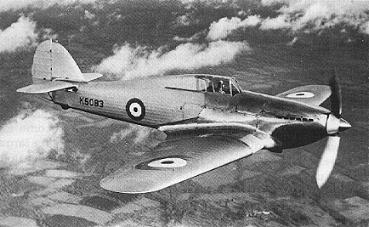
In 1933, the chief designer of Hawker, Sydney Camm, proposed a design of a new monoplane largely based upon the Hawker Fury biplane, to be powered by the Rolls Royce Goshawk engine. As the development began, the Goshawk was replaced with a Rolls Royce P.V.12 Merlin engine. The Hurricane was the basis for the Air Ministry Specification F.36/34. The airframe design was rather conventional for the period with fabric covered wings and fuselage. The new fighter was to have retractable landing gear and the tailplane was braced in the original design, although this was later replaced with a cantilever design. The prototype made its first flight on November 6, 1935 and easily exceeded the required performance goals.
The new fighter began its service trials in February 1936 and an order was placed in June for 600 production aircraft. This rather large number certainly reflected the growing concerns over the re-emergence of Germany as a military power. There was however, one problem presented by the Air Ministry that ultimately delayed production. The order called for the fighter to be powered by the new Merlin II engine. This then required Hawker to re-design the powerplant installation. Finally, the first production Hurricane made it’s maiden flight on October 12, 1937. By January 1938, the first operational RAF squadron was fully equipped with Hurricanes. By the end of 1938, about 200 of the aircraft were in service.
Designated as the Hurricane Mk I, the aircraft was modified several times during the course of its production. The fabric covered wing was discarded and replaced by a stressed aluminum design. Other improvements included changing over to the Merlin III engine, and the addition of increased pilot protection, such as armor behind the seat and a bullet resistant windscreen.
The Air Ministry, in 1938, in response to the rapid build up of the German Luftwaffe, and in no small measure influenced by the Condor Legion’s participation in the Spanish Civil war, determined to increase the Hurricane’s production rate considerably. As a result, Gloster Aircraft was selected to be tooled up for Hurricane production. The first Gloster built Mk I took to the air in October 27, 1939. By now Britain was at war with Germany.
At the time of Germany’s invasion of Poland in September 1939, nineteen squadrons were equipped with the Hurricane Mk I. Before being forced to abandon France at Dunkirk, the RAF lost or abandoned nearly 200 Hurricanes during the Battle of France, about 25% of its total front line strength at the time. With the British Army suddenly finding itself ill-equipped (much of it’s equipment was left behind in France) and the RAF seriously short of fighters, it was exceedingly fortunate that Germany was unprepared to mount a cross channel invasion close on the heels of the Dunkirk evacuation. Moreover, the Luftwaffe was unprepared to support an invasion. This bought the RAF a few weeks to reinforce their fighter arm. By the time of the opening of the Battle of Britain on August 8, 1940, the RAF could field 32 fresh squadrons of Hurricanes and 19 squadrons of Spitfires. At the time, Canadian built Hurricanes were beginning to arrive as well.
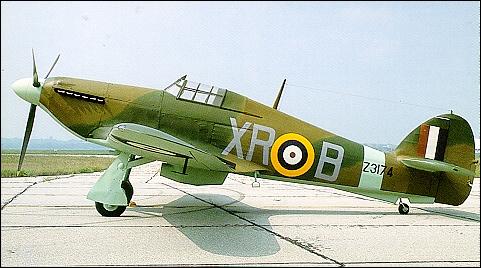
Development of the Hurricane continued with the Mk IIA being introduced with a slightly lengthened fuselage and the installation of the Merlin XX engine. The next variant incorporated a newly designed wing which had twelve .303 caliber machine guns installed and the provision to carry up two 500 lb (227 kg) bombs. Designated as the Hurricane Mk IIB, it was eventually superseded by the Mk IIC which had the Browning .303 machine guns replaced by four Hispano 20mm cannons. A redesigned wing was incorporated in the Mk IID with two 40mm cannon installed along with two .303 caliber machine guns used as aiming or "spotting" weapons. The final production variant was the Hurricane Mk IV or Mk IIE as it was sometimes designated. Equipped with the Merlin 27 engine of 1,650 hp, it was the most powerful of the lineage having evolved from the 990 hp prototype of 1935.
There is no question that the Hurricane was one of the truly great fighters of World war II. Even though it was soon obsolescent as a first line fighter, it proved to be a valuable fighter/bomber in North Africa and soldiered on in service in various Air Forces until nearly 1950.
Some of the countries that used the Hurricane include the Soviet Union (2,952), and India (300).
The total of all variants manufactured, including Sea Hurricanes, was 14,533 aircraft.
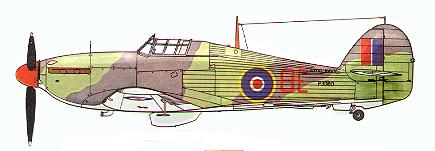
Dimensions:
Wingspan: 40 ft, 0 in.
Height: 13 ft, 1 in.
Weights:
Mk I: 4,982 lbs empty, 7,490 lbs maximum.
Mk IIC: 5,657 lbs empty, 8,250 lbs maximum.
Armament:
Mk I: Eight .303 Browning machine guns with 333 rounds per gun.
Mk IIC: Four 20mm Hispano cannon and up to 1,000 lbs of bombs.
Performance
Max speed:
Mk I: 322 mph at 22,000 ft.
Mk IIC: 342 mph at 22,000 ft. (Sea Hurricane Mk IIC: 336 Mph at 18,000 ft.).
Service ceiling:
Typical all Marks: 36,500 ft.
Range on internal fuel:
Mk I : 505 miles.
Mk IIC: 480 miles.
The Tornado and Typhoon
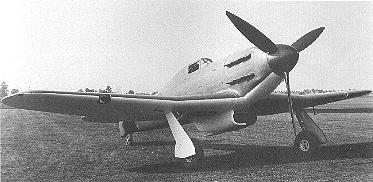
Even as the Hurricane was going through its service trials, the Air
Ministry issued another
specification for the Hurricane’s replacement. Specification F.18/37 set
the parameters for
this new fighter, and required it to utilize either the then under
development Rolls Royce
Vulture or the Napier Sabre engine. Hawker’s Sydney Camm set to work and
he and his team designed a fighter that would be tested with each
engine. The Vulture powered fighter was designated as the Tornado. The
Sabre powered airframe was designated as the Typhoon.
Camm’s design retained many of the characteristics of the Hurricane. The radiator was mounted below the fuselage. The vertical stabilizer was very similar in shape to its ancestor. Of far more importance, the wing design retained the excessively thick cross section. The aircraft’s cockpit design was very poor. Access to the cockpit was through a door on either side of the fuselage. This arrangement was very much like that of the American P-39 Airacobra. However, unlike the P-39, visibility was poor, even terrible. Both designs incorporated twelve .303 caliber machine guns in the thick wings. The first Tornado prototype flew on October 6, 1939.
From the outset, the Tornado suffered from several serious problems. The Vulture engine did not produce the specified horsepower. Worse, the engine was monumentally unreliable. Cataclysmic failures were the order of the day. The excessively complex engine plagued not only the Tornado program, but made an utter shambles of Avro’s Manchester bomber program as well. It has been said that Rolls Royce was too occupied with the Merlin to devote adequate resources to the proper development of the Vulture. Yet there exists significant evidence that the design was flawed beyond correction, and that Rolls Royce knew this early into the program.
In addition to the self destructive properties of the Vulture, the Tornado suffered from severe overheating due to the radiator location. Perhaps the most important problem, especially in the view of those who had to fly the Tornado and early Typhoons, was an inherent weakness of the rear fuselage that would, when over stressed, simply fail. This resulted in several pilot deaths and nearly ended both programs. The problem was later rectified with the Typhoon Mk.IB.
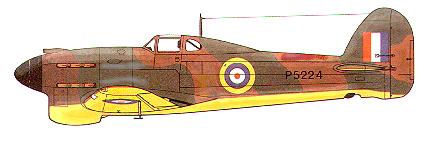
As frustration with the Vulture increased, the design team began looking at alternative engines for the Tornado. Deeming the Bristol Centaurus CE.4S radial to be adequately reliable, one of the Tornado prototypes was re-engineered to accept the 2,210 hp radial.
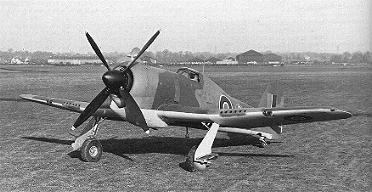
Once again, however,
overheating was a problem. The engine cowling was redesigned to solve the problem, which it
did in fact solve. However, by this time Typhoon development was moving along nicely, despite
some problems with the Sabre engine. As a result, the Tornado was abandoned and all resources were put into the Typhoon.
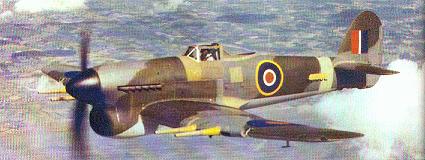
The first Typhoon took off on its maiden flight February 24, 1940. Initially, the aircraft’s handling was less than satifactory, and eventually the tail separated itself from the fuselage do the weakness discussed earlier. Further development took more than a year before the first production Mk.IA left the Gloster line for its first flight. There were still serious problems. The Sabre was not yet debugged sufficiently and the airframe weakness was not yet properly cured. Moreover, the Typhoon’s performance at altitude was poor. It displayed a rate of climb that was not any improvement on the Hurricane. The entire program came within a hairs breath of being cancelled.
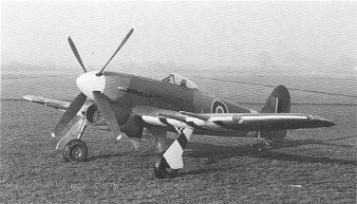
It was to take more than another year, into late 1942, before the
fuselage was adequately reinforced
and engine reliability was at barely acceptable levels. Gradually, the
Typhoon’s strengths came
to light. Very fast at low altitude, it could chase down German low
level raiders. Armed with four
20mm Hispano cannons, the Typhoon began to demonstrate it’s ability at
ground attack. The
wing was reworked twice to carry up to two 500 lb bombs or eight 60 lb
rockets. It was in using
these rockets that the Typhoon gained its reputation as one of the most
effective fighter-bombers of the war. Along with Republic P-47
Thunderbolts, the Typhoons ranged over
ETO battlefields destroying German armor and just about anything else
that dared show
itself during daylight hours. The contribution of the Typhoon to the war
effort can never
be overstated.
Hawker, however, could not envision that the Typhoon would become the scourge of the Wehrmacht. Moreover, Camm realized that the thick wing section limited maximum speed and lowered the critical Mach. Therefore, an improved design designated the Typhoon II was on the drawing boards. Later, it would be renamed Tempest.
Specifications: Typhoon Mk.IB
Dimensions:
Wing span: 41 ft, 7 in
Length: 31 ft, 11.5 in.
Height: 15 ft, 4 in.
Weights:
Empty: 8,800 lbs.
Maximum: 11,400 lbs.
Powerplant: One 2,180 hp Napier Sabre IIA 24 cylinder sleeve valve ‘H’ piston engine.
Armament: Four Hispano Mk.II 20mm cannon. Eight 60 lb rockets or up to 1,000 lbs of bombs.
Performance:
Maximum speed: 405 mph @ 18,000 ft.
Service ceiling: 34,000 ft.
Range with maximum load: 510 miles.
The Tempest
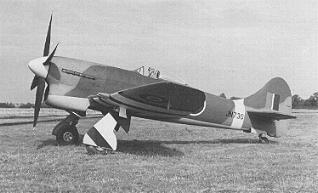
One of the earliest reasons for designing a successor to the Typhoon was
the disappointing
performance of the Typhoon at altitude. The original specification
defined an interceptor. The Typhoon was
decidedly un-interceptor like in climb rate and performance above 25,000
ft. The other problem
haunting the Typhoon was a tendency to buffet and nose over in high
speed dives. Sydney Camm was convinced that this was the effects of
compressibility, when the air flow across the wing would approach
supersonic speed in a localized area. Therefore, Camm finally discarded
the thick cross section wing design he had clung to since designing the
Hurricane. The Typhoon II would have a thinner wing, not unlike that
already used by the Spitfire and America’s P-47
Thunderbolt (Seversky, later to become Republic, had used the elliptical
wing planform long
before Mitchell adapted it to the Spitfire). The new elliptical wing no
longer had the internal space
for fuel tanks. Therefore the fuselage was stretched and a fuel tank
added between the engine
and the cockpit. Lengthening the fuselage then necessitated the
additional of a dorsal fillet to the vertical stabilizer to restore
directional stability. The original idea included moving the coolant
radiators to the wing leading edges, not unlike the de Havilland
Mosquito.
Hawker’s new design proposal was submitted to the Air Ministry who, in turn issued Specification F.10/41. Two basic engines were selected. The Sabre IV for the Tempest Mk.I and the Sabre II for the Tempest Mk.V. Additional prototypes were built utilizing the Bristol Centaurus radial engine (the data from the Tornado was finally reaping some benefit), and one to be fitted with the Rolls Royce Griffon 61. The Tempest Mk.I flew for the first time on February 24, 1943. This aircraft had it’s radiators within the wing and managed to reach a speed of 466 mph.

Early production versions of the Tempest Mk.V were fitted with Hispano Mk.II 20mm cannons which protruded from the leading edge of the wing. Later aircraft were armed with the newer Hispano Mk.V which had shorter barrels that mounted flush with the leading edge of the wing.
The first Tempest Mk.V fighters began active duty service in April 1944. The first Tempest wing was formed within No. 85 Group. With the appearance of the German V-1 flying bomb in mid-June, the Tempests where called upon to intercept and destroy the Nazi menace. In this role, the Tempests performed very well. Being, perhaps the fastest Allied fighter below 10,000 ft, the new fighter could quickly overhaul the V-1s and destroy them with cannon fire or tip them over with their wing tips which tumbled the V-1’s gyro causing it to lose control and crash. The Tempests accounted for nearly 30% of all the flying bombs brought down by aircraft. Over the Continent, the Tempests flew in support of the advancing ground forces, proving to be at least as effective as the Typhoon. In aerial combat, they gave a good account of themselves, proving to be a match for the Luftwaffe’s best. Tempest pilot claims to shooting down 20 Me-262 jet fighters in the final six months of the war tends to demonstrate the fighter's excellent performance.
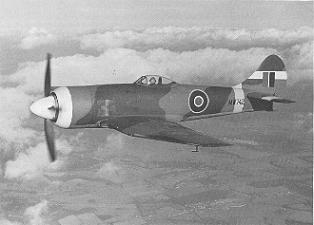
In addition to the Tempest Mk.V, the new Tempest II made its appearance in October, 1944.
Not reaching operational squadrons in time for the last months of the war, it was the final variant of the Tempest.
The first 100 were manufactured by Bristol, with the balance of production reverting to Hawker. Most of those who flew both the Sabre and
Centaurus powered Tempests were in agreement that the radial engine fighter was the superior of the two. It was far more dependable, and both
smoother and quieter as well. It became the standard post war variant along with its direct descendent, the even better performing Sea Fury.
Specifications: Tempest Mk.V
Dimensions:
Wing span: 41 ft, 0 in.
Length: 33 ft, 8 in.
Height: 16 ft, 1 in.
Weights:
Empty: 9,000 lbs.
Maximum: 13,540 lbs.
Powerplant: One 2,180 hp Napier Sabre IIA 24 cylinder sleeve valve ‘H’ piston engine.
Armament: Four Hispano Mk.II or Mk.V cannon. Eight 60 lb rockets or up to 2,000 lbs of bombs.
Performance:
Maximum speed: 426 mph @ 18,500 ft.
Service ceiling: 36,500 ft.
Range, internal fuel: 740 miles.
